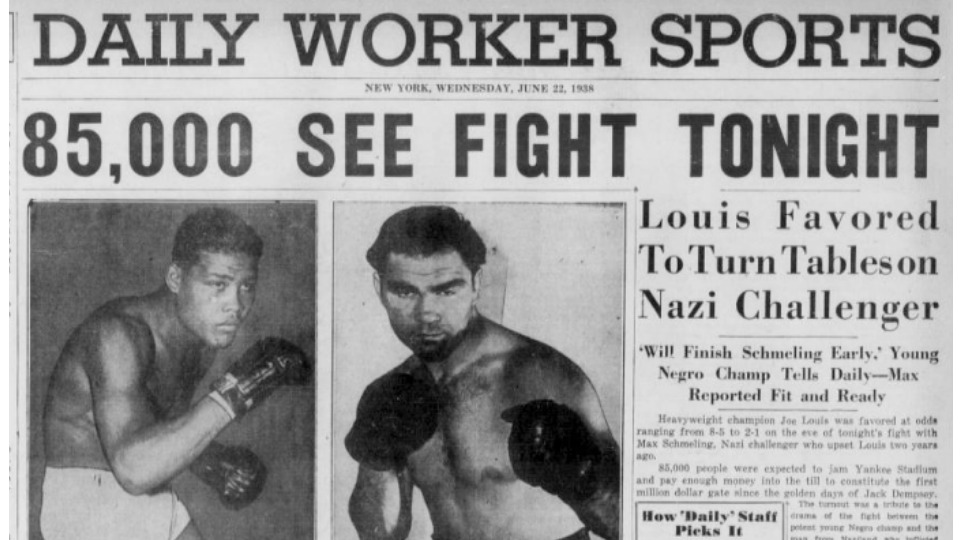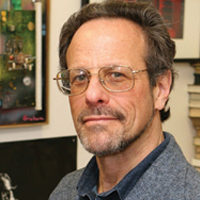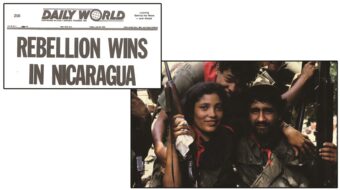
It is difficult to defend boxing. It is often brutal, and sometimes deadly. Its less odious, even admirable, traits involve skill, speed, tactics, concentration, and movement. In combination with the strictest safety precautions, and free of criminal control, dubious elements, and economic exploitation, it can be deemed a sport. But its very aggression mandates caution in any assessment.
Boxing pre-dates capitalism. Incitement to murder for a thrill in general, and gambling returns in particular, transcends boxing per se, but emanates from a culture that views workers and oppressed people as things and treats force and violence as casually as drinking milk. Of course, class societies prior to capitalism latched their coattails to combat as entertainment. But incapacitation at a bloody cost is a special money-maker in modern context. Profits infect sports under capitalism. Assault can be a profitable spectacle.
Competitive sport and decay are not one and the same, but competition can also go too far even under non-capitalist circumstances. I attended an amateur boxing tournament in Hungary when it was a socialist-oriented country, at the invitation of longtime Budapest resident and British Communist Charlie Coutts. It involved boxers from Cuba, Nigeria, Italy and Hungary. To an extent it resembled all such competitions of the time: smoke filled the air, one periodically heard invocations to “kill em.” The requirement to slug still held true, but the generally civil conduct between competitors was clear, in the ring no less: they were not prizefighters. Coutts also got me a ticket for a World Cup preliminary between the Soviet Union and Hungary, the latter emerging victorious. In a sign of celebration as well as nationalism, a car outside the stadium was overturned and set afire, a disturbing sight under any social system. Yet the systemic mechanisms driving corruption did not exist and the athletes were not under corporate control.
Most athletes remain true to mutual regard, matching of skill, and sportsmanship, despite the constant drumbeat to humiliate and harm. Critics of capitalism have as much responsibility to evaluate and critique boxing as they do all phenomena under capitalism.
The book under review is a good example of how this can be accomplished. Noted U.S. historian Gerald Horne’s numerous works include The Counter-Revolution of 1776 and The Apocalypse of Settler Colonialism. Insofar as his new book on boxing deals heavily with the role of mobsters and organized crime, his previous Jazz and Justice and Class Struggle in Hollywood established Horne’s insight into the integration of mobsters into U.S. capitalism.
Indeed, Horne focuses on the U.S., though his findings pertain to the control of boxing in other countries, such as South Africa. After all, the professional boxing authorizing bodies—World Boxing Council, International Boxing Federation and others, with their proliferating dozens of new weight classes—are international. Horne employs boxing commission records, minutes of regulatory agencies, oral histories, state gaming commission documents, papers of civil rights organizations and figures, trial testimony and oral histories—a thorough and impressive range of sources.
Horne addresses the historical ties between violence and systems based on class division. Similarly, he demonstrates resistance by officially disarmed lower classes, including weaponless approaches to self-defense. Nelson Mandela was one of many progressive figures with a boxing history.
The peculiar American background
Horne establishes the American background in the origins of racism and slavery in North America. As in ancient Rome, where slave gladiators fought to the death for the entertainment of spectators, U.S. slavery manifested similar obsessions. The latter, notes Horne, “was notorious for the arranging of fighting contests among enslaved men in particular,” where masculinity was honed, evoking “the overriding bellicosity of U.S. culture.” Horne mentions the attendant “theory” that African and African American slaves were impervious to pain. On this score, Medical Apartheid by Harriet Washington is recommended.
Horne also observes that slaves fought the brute force of those who owned and controlled them. He refers to Frederick Douglass, former slave and eventual abolitionist leader in both the U.S. and Britain. Douglass’s autobiography details his repulsing of an attack by Covey, the notorious “slave-breaker” (an unusually accurate job title):
Mr. Covey seemed now to think he had me, and could do what he pleased; but at this moment—from whence came the spirit I don’t know—I resolved to fight; and, suiting my action to the resolution, I seized Covey hard by the throat; and as I did so, I rose. He held on to me, and I to him. My resistance was so entirely unexpected that Covey seemed taken all aback. He trembled like a leaf. —Narrative of the Life of Frederick Douglass, An American Slave, Written by Himself, 1845, p. 73.

The integration of violence and racism remained a constant, keynoted by lynching and continued with vigor today by police departments.
By the time of the emergence of imperialism at the end of the 19th century, U.S. culture had harnessed theories attesting to the benefits of conquest by “real men,” and other shows of strength apparently bearing out the importance of physically subduing others. Professional boxing went on to display an inherent sexism and latent or blatant homophobia. Horne pithily captures what Emile Griffith did to his homophobic opponent Benny Paret, who mocked Griffith’s alleged sexual orientation: Griffith “methodically executed him in the ring.”
Prizefighting at first inspired mixed reactions as well as criticism as a near-barbaric pursuit. But Horne points out how imperialism served to legitimize physical force: U.S. president and eugenics advocate Theodore Roosevelt successfully produced a merger of intense compulsion as manhood with the virtues of colonial conquest and the laws of racial superiority. Sexism was especially emphasized in the royal treatment of the heavyweight division, where the best incarnations of male domination could allegedly be found—unless those involved were African-American or Jewish. Horne details both the emergence of and discrimination against boxers from nationally oppressed groups. Despite anti-Semitism, Jewish boxers held a certain sway in professional boxing for a while, winning numerous titles while Blacks were essentially excluded. Horne mentions champion Barney Ross as an example, a skilled boxer but controlled by gangster Al Capone.
Racism manifested in the pay differentials for white and Black boxers; stealing black fighters’ promised money outright; and the grave threats and isolation accorded African-American fighters like Jack Johnson, who fought at a time when it was illegal to hit a white man, or for that matter to have a relationship with a white woman.

Hence the calls almost from the get-go for white “hopes”—James Braddock, Gene Tunney, Gerry Cooney—toward the ostensible goal of white race survival and the rescue of white women from the onslaughts of African-American men. Racism extended to the amateur ranks too: The Amateur Athletic Union for a time banned interracial boxing. When Black fighters, often thanks to growing TV markets, became more prominent and often fought each other, both promoters and press created dichotomous images of decent versus savage. When Muhammad Ali came out against the Vietnam War, the advertised clash was between traitors and patriots.
The Mob moves in
At first regarded as unseemly and forced into remote areas of the country, like the emerging state of Nevada, boxing gained traction as it became a clear money-making enterprise in the operation of organized crime in the 1920s. Still, it took a while before the most brutal incidents were investigated and steps were taken to prevent them. Horne mentions that a Mob-associated trainer inserted a layer of cement plaster into Jack Dempsey’s gloves for the consequently sanguineous heavyweight title clash with Jess Willard. The trainer went on to a long career as a boxing “fixer” for crime syndicates. However, adopting a modicum of protective measures did not erase the brutality of the “sport,” the resulting brain damage, and the life-threatening problems engendered by the strenuous effort to maintain weight eligibility for the different boxing classifications.
Nearly all the chapters detail the mechanics of criminal control over boxing in the United States, but Horne brings the matter into clearer focus at certain points. Well established promoters Bob Arum and Don King made arrangements with organized crime organizations. King’s Mob ties were deeper. African-American promoter Truman Gibson was less enthused and more resistant to such connections and, as Horne shows, paid for it in a trial that singled him out for practices far less corrupt than those of his white confreres in the business. Al Capone and the criminal businesses headed by the Jewish-led gang Murder Inc., the Gambinos, Genoveses, and Luccheses circulated naturally in the netherworld of prizefighting. Boxing trainers Lou Duva, Cus D’Amato (who worked with heavyweights Floyd Patterson and Mike Tyson), and Angelo Dundee (Muhammad Ali’s man in the corner) are among those whom Horne specifies as “connected.” Under the jurisdiction of promoters, trainers, and mobsters, boxers were cheated, shortchanged, set up, exploited. Joe Louis, the champion who defeated Nazi Max Schmeling in 1938, lost promised payments and made desperate efforts to find work after retirement; Horne indicates his relationship with Harlem gangster Bumpy Johnson.
Boxing judges also fell into the category of the ethically challenged, along with managers, promoters, and trainers. Most properly, then the terrain shifted to the gambling sites under the greatest influence of criminal syndicates: Nevada, and Atlantic City in New Jersey. Here also were based prominent political and business figures who celebrated the exploitive cause by self-enrichment. As Horne puts it, “Like flies to feces, the odoriferous sport attracted human scum effortlessly.” The slime created Donald Trump, facilitated into boxing prominence by his mentor, the virulently corrupt McCarthyite attorney Roy Cohn, prosecutor of Ethel and Julius Rosenberg.
Boxing and politics
Horne carefully notes the interplay of boxing and politics. Jack Johnson, the first Black champion to inspire a nearly hysterical search for a “white hope,” espoused strong opposition to racism, settling in Mexico during the Mexican Revolution of the early 1900s with its advocacy of land reform and nationalization of foreign companies. He also denounced the rise of Hitler, earning admiration by progressives and Communists. Joe Louis supported several Communist Party USA-led organizations in the 1940s, backed anti-war Progressive Party candidate Henry Wallace in the 1948 Cold War presidential election (Paul Robeson was one of Wallace’s most active campaigners), and endorsed Communist Benjamin Davis’s election to the New York City Council. Davis went to prison during the McCarthy period.
Louis’s interviews with the Daily Worker, the Party newspaper, were a regular feature. He called for the removal of restrictions on African-American voters, and an end to segregation. Lightweight Henry Armstrong enunciated similar principles. Another boxer with leftwing affinities was the future actor Canada Lee, who would later be blacklisted from the film industry. Instances of boxers—including several with random Mob connections—speaking out in support of labor causes and strikes were not uncommon.

However, boxer Sonny Liston, whom Muhammad Ali defeated to win the heavyweight title in 1964, served the Mafia as a violent scab protector in strikes. He also stands as one of the most exploited boxers in history. Horne mentions that three organized crime figures regularly drew 76% of Liston’s earnings.
At the same time, a number of boxing figures held right-wing opinions. One was 1920s champion Gene Tunney, who expressed fascist sympathies and clearly articulated his fervent opposition to fighting Black opponents. Later, this trend metamorphosed into validating the South African apartheid regime as a worthy partner on the world boxing stage, giving recognition to fights held there, and backing its government as an exemplary partner in sportsmanship. The ever-present enterprise of “white hopes” validated apartheid’s boxing champions and fueled their integration into the rankings and the matches. Angelo Dundee, Muhammad Ali’s trainer, organized a number of these fights, as did the promoter Bob Arum. Boycotting and isolating apartheid-sponsored bouts became in turn a component of the anti-apartheid movement internationally.
After Muhammad Ali refused to serve in the U.S. military during the Vietnam War, establishing himself as a principled voice amidst the milieu of a growing peace movement, he was deprived of his heavyweight title and access to all boxing venues for three years. A boycott of the 1968 Olympics by many African-American athletes, as well as protests during the Games, indicated support for Ali and registered outspoken stances for peace and against racism, including by sympathizing white athletes. Writes Horne: “Ali placed himself broadly within the ranks of the mass dissent that bubbled to the surface in the 1960s, driven by the anti-Jim Crow and antiwar movements.”
But rival boxers did not hesitate to criticize Ali, a Muslim, as a traitor to the nation as well as to Christianity. Critics expounding rightwing attacks on Ali included future opponents Joe Frazier and George Foreman. Foreman associated himself with pro-war jingoism as a challenge to Ali’s anti-war position, making Ali’s 8th-round knockout of him politically symbolic.
Horne’s analysis of Ali demonstrates that the boxer was somewhat protected from the sport’s worst practices by the fact that he belonged to the African-American nationalist organization, the Nation of Islam. The organization assumed the role of managing Ali’s career, appointing Herbert Muhammad, a son of the founder, to fulfill that role. Though Muhammad was no model of integrity either, the Nation of Islam’s own security force helped to reduce outside criminal access to the fighter. Nevertheless, it was nearly impossible to avoid discredited forces in prizefighting, and Ali fought more than one Mob-paid opponent, engaging in many bouts organized by the corrupt promoter Don King. Then too, Ali’s trainer had his own criminal associations, as Horne points out while demonstrating certain other contradictions.
Thus, while Ali did not fight South African fighters, he apparently did consider it. Still, the anti-war Ali visited the Soviet Union in 1978, met Communist leaders, and spoke out quite favorably on Soviet life:

Lenin was a common man. He was from the community. Does Communist mean community? Commune, common, or community? What’s wrong with the common man? What’s wrong with helping the community? So communism, it seems to me, if it means community, isn’t a bad word.
But Ali endorsed right-winger Ronald Reagan for president in 1984.
Among the offspring of the political economy of boxing were the innumerable cases of deaths, permanent injury, or brain damage: Horne spares no words on this score. One need only glimpse the films of Briton Henry Cooper’s fights to see mass bleeding at work.
Horne’s exposure of the nexus of profit, racism, and gangsterism is profound enough to conclude that capitalism and organized crime are synonymous. He concludes with a call to unionization. Boxers can only advance and improve their conditions, gain pensions and quality medical care if they organize collectively, even though they engage in singularly individualistic work. At an early 1980s World Boxing Council convention, several boxers supported some form of unionizing. They argued that only a handful earn multi-millions. But what of the care, health, and wellbeing of those who don’t? In a response similarly witnessed by tennis players seeking to organize, managerial representatives insisted that any such group be a joint trade association representing the supposedly mutual interests of boxers, investors, promoters, and managers.
Globally, corporations and governments have made a custom of defining many categories of workers as independent operators, thus undermining union drives in a wide range of industries. Horne concludes: “The admirable proposal—and the swift deep-sixing of it—too were part of the bittersweet reality that continues to animate boxing.”
Gerald Horne
The Bittersweet Science: Racism, Racketeering and the Political Economy of Boxing
New York: International Publishers, 2021
329 pp., $19.99
ISBN: 9780717808298
Order the book here.
We hope you appreciated this article. At People’s World, we believe news and information should be free and accessible to all, but we need your help. Our journalism is free of corporate influence and paywalls because we are totally reader-supported. Only you, our readers and supporters, make this possible. If you enjoy reading People’s World and the stories we bring you, please support our work by donating or becoming a monthly sustainer today. Thank you!












Comments